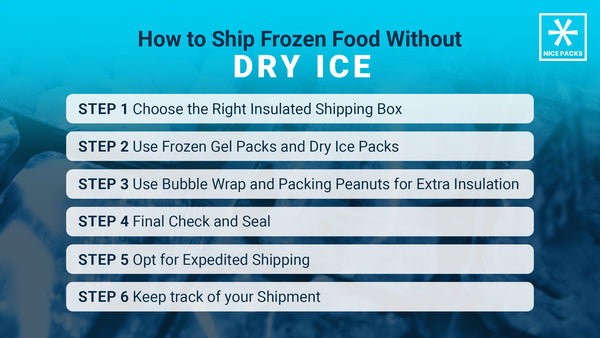Shipping frozen foods without dry ice requires some clever thinking. While dry ice is the typical choice for keeping items frozen during transit, there are alternative methods available. In this blog post, we'll explore how to successfully ship frozen food without relying on dry ice. Let's get started.
Why Choose Alternatives to Dry Ice?
While dry ice is an effective method for keeping food frozen, it's not always the best choice for every situation. Here's why exploring alternatives to dry ice can be beneficial:
1) Safety Concerns
Credit: Envato Elements/ thichaa
Dry ice is frozen carbon dioxide, which is extremely cold (-78.5 degrees Celsius or -109.3 degrees Fahrenheit) and can cause burns if handled without proper protection. Also, it sublimates into carbon dioxide gas as it melts, which can be dangerous in enclosed areas if not ventilated correctly.
2) Regulation Concerns
Credit: Envato Elements/ MargJohnsonVA
Shipping with dry ice can be subject to specific regulations. Some shipping providers have strict guidelines on how much dry ice you can use in one package. They might also require you to use special labels and file additional paperwork.
3) High Costs
Credit: Envato Elements/ BrianAJackson
Dry ice often costs more than alternatives like gel packs. This is because using dry ice involves not only buying the substance itself but also the special handling and packaging needed, which adds to the overall expense.
How to Ship Frozen Food Without Dry Ice

To ship frozen food without dry ice, follow the steps below:
Step 1: Choose the Right Insulated Shipping Box
Credit: Envato Elements/ FabrikaPhoto
The first step in successfully shipping frozen food without dry ice is selecting the right insulated foam containers or frozen food shipping containers. These containers, like Styrofoam, have insulation that slows down heat transfer, keeping the food frozen.
Make sure to choose a container that fits your food snugly. Too much space can increase heat transfer and thaw your food.
Step 2: Use Frozen Gel Packs and Dry Ice Packs
Credit: Envato Elements/ vsoldatov7
Gel packs and dry ice packs are great alternatives to dry ice for shipping frozen food. These reusable packs are filled with a special material that freezes to a very low temperature. hey stay flexible when frozen and are perfect for keeping your refrigerated and frozen foods cold. Also, they're great options if you want to ship frozen food cheaply.
To prepare your ice packs for shipping, freeze them for 24-48 hours. Line the bottom of your insulated box with the packs, then add the frozen food on top, and finally, add more packs to make sure everything is fully surrounded.
Step 3: Use Bubble Wrap and Packing Peanuts for Extra Insulation
Credit: Envato Elements/ alexstand
While insulated boxes and cold packs are your primary tools for keeping your food frozen, bubble wrap and packing peanuts can add an extra layer of insulation. These are lightweight and budget-friendly packing materials that can fill any extra space in your box, preventing the amount of warm air from getting in.
Step 4: Final Check and Seal
Credit: Envato Elements/ megostudio
Before sealing your package, double-check everything. Make sure your frozen and cold foods are surrounded by cold packs and bubble wrap. Also, make sure there is minimal empty space. Once everything is in place, seal the package with specially designed shipping tape.
Step 5: Opt for Expedited Shipping
Credit: Envato Elements/ vanenunes
Don't forget, time matters when shipping frozen food. The longer the transit time, the more likely your food will begin to thaw. To make sure your package arrives safely and quickly, pick a shipping carrier that provides expedited shipping options and can ship frozen food overnight. USPS Priority Mail Express is a good choice.
Step 6: Keep Track of Your Shipment
Credit: Envato Elements/ ijeab
While shipping frozen food promptly is important, it's equally important to keep an eye on the progress of your shipment. Use the tracking services provided by courier companies to know where your package is. This allows you to inform the recipient when to expect the delivery, so they can plan to store the food properly when it arrives.
FAQs
What foods are best to ship without dry ice?
Foods that are less perishable and can withstand moderate temperatures are best to ship without dry ice. Some examples include:
-
Dried fruits and nuts
-
Canned goods
-
Certain types of baked goods like cookies and crackers
-
Jerky and other preserved meats
-
Hard cheeses
What should you look for when choosing the right carrier for shipping?
When selecting a carrier for shipping perishable items, consider the following factors:
-
Reputation for handling perishable goods
-
Speed and reliability of delivery
-
Quality of insulation and packaging options
-
Ability to track shipments in real-time
-
Cost-effectiveness of shipping rates
What should I do if my frozen goods arrive thawed?
If your frozen goods arrive thawed, it's essential to check their condition immediately. Depending on the type of food and how long it has been thawed, it may still be safe to consume. Contact the shipping carrier and document any issues or damages to file a claim if necessary.
Can I reuse dry ice packs?
Yes, dry ice packs can often be reused. Once they have fully melted, you can simply refreeze them in by placing them in a freezer.
How long can frozen goods typically last during shipping with dry ice?
This depends on the type of product, insulation quality, ambient temperature, and the amount of dry ice used. However, in general, dry ice can keep items frozen for up to 24-48 hours.
Summary
Shipping frozen food without dry ice might need a bit more planning, but it's doable with the right supplies. By choosing quality insulated coolers, using cold packs, packing your items properly, and selecting an expedited shipping method, you can ensure your frozen food arrives at its destination in excellent condition.
Looking for the perfect solution to ship your frozen goods? Check out Nice Packs! Our high-quality dry ice packs and insulated containers are designed to keep your perishable items frozen during transit. Shop with us today.











